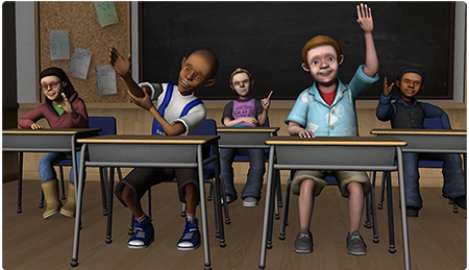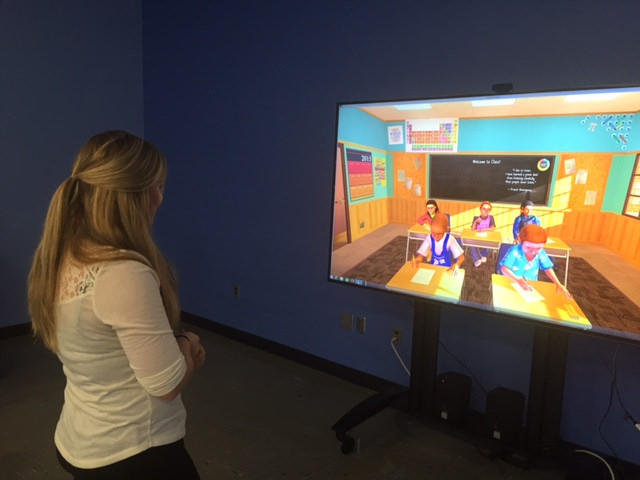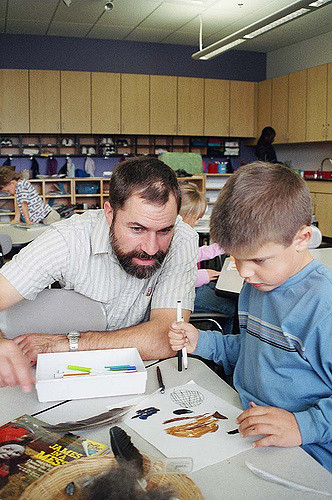
Just when you think the masters of the universe who run the corporate reform movement can’t be even more clueless, you catch wind of the newest effort to turn education into a profit-generating endeavor–this time, a hare-brained scheme to evaluate student teachers, by…and I swear I’m not making this up…observing them as they pretend to teach…wait for it…a fake “classroom” of avatars, in a virtual reality environment.
Avatars.
Avatars!
AVATARS!!!!!
Don’t believe it? Neither did I until I took a look at the new “National Observational Teaching Exam,” or NOTE, brought to you by the Educational Testing Service (ETS)–the same company that brings us the Graduate Record Exam (GRE), the SAT, the PRAXIS tests, the AP Exams, and the National Assessment of Educational Progress (NAEP).
NOTE works like this: a teacher candidate (student teacher) “teaches” a sample lesson for 6-7 minutes using a “virtual class” populated by 5-6 “avatar students,” and receives feedback from an artificial intelligence program. The NOTE system is a combination of video production and “advanced technology” developed by the US Military, according to Mark Atkinson, the CEO of the tech firm Mursion, Inc., which is responsible for the creation of the avatars and virtual reality environment used in NOTE.
ETS describes NOTE as a program that promises to “measure a teaching candidate’s readiness to teach in ways that are representative of real-life teaching experiences.” The operative word here is “representative,” as the teacher candidates are not assessed by observing their work in an actual classroom, with real live children…
Because a teacher’s interaction with students is an integral part of certain high-leverage teaching practices, ETS and TeachingWorks are designing and prototyping virtual classrooms with interactive avatar students. In partnership with Mursion™, which provides a mixed-reality teaching environment with simulated students, the avatars are produced by trained, calibrated human “interactors” using standardized protocols. The use of virtual classrooms not only supports greater standardization of instructional contexts and settings for candidates, but also eliminates disruption to classroom activities, curriculum and student learning that occurs in schools.

“Simulated students.”
“Trained, calibrated human ‘interactors.'”
“Greater standardization of instructional contexts and settings.”
These words should be chilling to anyone who has ever set foot in a classroom, has ever taught a child, or who believes that the purpose of education is the development of relationships between learners and teachers–and among the learners themselves.
Teacher candidates can’t develop relationships with “simulated students.”
Teacher candidates should not be evaluated by “trained, calibrated human ‘interactors'”–to be honest, I’m not a fan of the word “training” in most educational settings, and I don’t even want to know how humans are “calibrated.”
And “greater standardization of instructional contexts” isn’t something we should consider a goal worth pursuing–standardization serves only to diminish and devalue the richness and diversity of the teaching and learning process.
To be fair, the educational principles behind NOTE are not without merit. The intellectual basis upon which the exam is based comes from TeachingWorks, an initiative housed at the University of Michigan under the leadership of Dean Deborah Loewenberg Ball of the UM College of Education. Dr. Ball’s work in identifying the particular kinds of knowledge and skills needed to teach specific subjects (for example, see: math knowledge for teaching) has been recognized as groundbreaking, and holds great promise.
Could one make the argument that virtual reality simulators, such as those used in the training of pilots, might be useful in certain methods classes, or as a supplemental or enrichment experiences for prospective or practicing teachers as ways to practice their teaching “moves” under low-stakes, relatively stress-free conditions? Of course.
However, what is profoundly troubling here is that there seems to be no understanding, or even consideration, of the impact of the use of this work in creating a high-stakes evaluation tool for prospective teachers. It’s one thing for teachers to lose their jobs for their students’ test scores, or for being denied certification as a result of not passing a high-stakes assessment such as edTPA. But we need to ask ourselves some serious questions as a profession when student teachers are being judged on the basis of their ability to teach a “class” of avatars, created by a high-tech firm–and being charged for the privilege.
The seemingly small step from “methods class supplement” to “high-stakes assessment tool” is a devastating miscalculation, and betrays a disappointing lack of judgment on the parts of all involved. And just so there can be no mistake about labeling the NOTE as a high-stakes tool, Mr. Atkinson, the CEO of Mursion, Inc., can be heard saying the following in this video: “We are working with ETS around the new NOTE assessment that they are rolling out as the Tier 1 licensing alternative to the edTPA.”
It is also worth mentioning that the funders for this initiative include the New Schools Venture Fund, Gates, Broad, Walton, Pearson, Bloomberg; aka, the usual suspects when it comes to corporate reform projects.
Perhaps the most troubling thing I encountered while looking into NOTE came while watching a video of the CEO of Mursion explaining the advantages of learning how to teach with computer simulated students, rather than real, live children. As he described a hypothetical teacher candidate making an error in explaining a math problem (why is it always math with the reformers?), Mr. Atkinson waxed poetic about the benefits of simulation in providing feedback to students: “You’re not missing a kid who may be turned off to mathematics, you’re missing an avatar that doesn’t matter.”
And therein lies the rub. There’s nothing about teaching that doesn’t matter. And learning how to teach with students, real or simulated, who “don’t matter” will only lead to the further deprofessionalization of teaching, not to the Brave New World promised by Mursion and ETS.
Teaching is a human activity, not a video game.
Becoming a teacher is a developmental process that is guided and nurtured by experienced colleagues and mentors, not measured by “trained, calibrated human ‘interactions.’
And learning how to teach requires caring–not the elimination of it.




